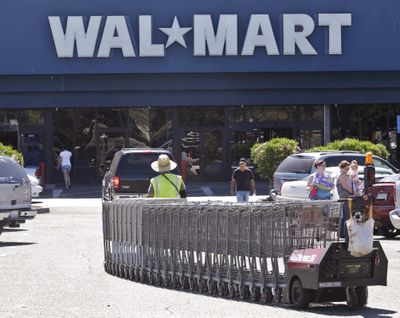Key retailers raise outlook
Wal-Mart, Home Depot latest to show optimism

NEW YORK – Consumers may not be confident, but the stores that sell to them certainly seem to be.
Wal-Mart and Home Depot, two of the nation’s largest retailers and bellwethers of the U.S. economy, on Tuesday joined a string of other merchants that have boosted their profit outlooks for the year despite a flow of bad economic news that suggests they have no reason to be optimistic. TJX Cos., which owns TJ Maxx and Marshalls, Macy’s Inc., Kohl’s Corp. and Nordstrom Inc. have all raised their outlooks in the past week.
Retailers’ results are a closely watched barometer of how willing Americans are to loosen their purse strings, which is important since consumer spending accounts for 70 percent of the economy. But at a time when families are being squeezed by rising costs, high unemployment, scant pay raises and a weak housing market, the positive forecasts seem to fly in the face of other economic indicators.
“It’s cautious optimism. Retailers want to be optimistic but they know consumers can turn on a dime,” said Wall Street Strategies analyst Brian Sozzi. “Retailers are still climbing a wall of worry.”
Merchants have plenty to worry about. They want to avoid a repeat of the aftermath of the financial crisis in 2008 when shoppers pulled back so much that revenue and profits suffered and some were forced out of business. Merchants are better positioned to weather the downturn now, but Americans have continued to cut back during the painfully slow recovery.
Consumer sentiment hit a 31-year low in August, according to a key survey completed last week, as stock market turmoil and recent political strife over raising the federal debt ceiling shook already nervous shoppers. And the International Council of Shopping Centers-Goldman Sachs index, which tracks revenue at stores that have been open at least a year at 27 major retailers, has shown three consecutive weeks of declines.
Still, retailers have some reason for optimism. Consumers spent more on cars, furniture, electronics and other goods in July – and more in May and June than previously thought. Retail sales rose 0.5 percent last month, the best showing since March, according to the Commerce Department.
Retailers also have learned from 2008 when they wound up with piles of unsold merchandise that they had to discount up to 80 percent or sell to liquidators for pennies on the dollar. In fact, several retailers that have survived the Great Recession by cutting costs, keeping inventories lean and pushing either low prices or high quality are reflecting confidence going forward.
Wal-Mart Stores Inc., the world’s largest retailer, accounts for nearly 10 percent of all nonautomotive dollars spent in the U.S. It said its core customers – low-income Americans – have been particularly hard hit by the economic downturn. Many say job security is their top concern.
But the retailer, which posted a 5.7 percent second-quarter profit increase due to strong international sales growth and cost cutting, said its strategy of going back to everyday low pricing instead of slashing prices temporarily on select merchandise, is resonating with cash-strapped consumers.
Wal-Mart raised its full-year guidance to a range of $4.41 per share to $4.51 per share, compared with the forecast it gave in February of $4.35 per share to $4.50 per share. Analysts had expected $4.46 per share.
Home Depot Inc., the nation’s largest home-improvement retailer, acknowledged that consumers are concerned about the economy. But the company said despite a weak housing market, it has gained market share in several categories including flooring, plumbing, electrical lighting and kitchens in the latest quarter.
The retailer reported that second quarter profit rose 14 percent. Home Depot also raised its full-year earnings guidance to $2.34 per share from $2.24, well above the $2.30 analysts were expecting. It still expects yearly revenue to rise 2.5 percent.
Other big retailers, including Target Corp. and Sears Holdings Corp., are expected to report earnings and forecasts later this week.